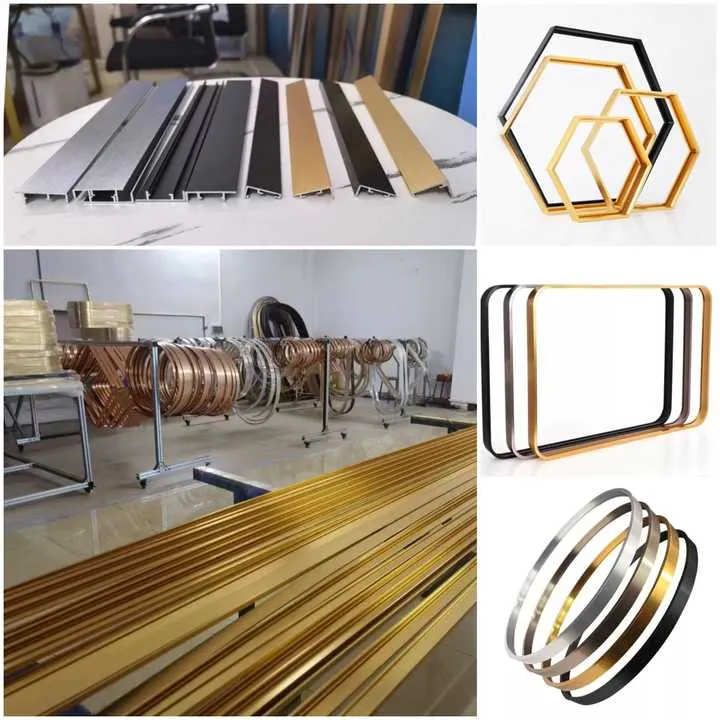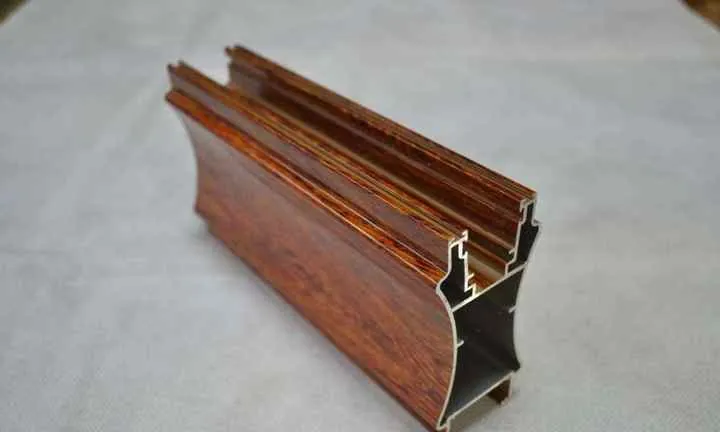الدليل النهائي للشرائط الانتقالية للأرضية؟

فجوات الأرضية القبيحة تفسد حتى أجمل التجديدات. فبدون الشريط الانتقالي الصحيح، تتأثر السلامة والأناقة على حد سواء.
تعمل الشرائط الانتقالية للأرضيات على ربط أنواع ومستويات الأرضيات المختلفة، مما يخلق انتقالات سلسة وآمنة وممتعة بصرياً بين الغرف أو الأسطح.
وغالباً ما يتم تجاهلها في كثير من الأحيان، ولكن بمجرد أن تتعلم مدى تنوعها وأهميتها، لن تتخطاها مرة أخرى.
ما أنواع الشرائط الانتقالية الموجودة؟

انتقالات الأرضيات ليست ذات مقاس واحد يناسب الجميع. فالمواد والسماكات والتطبيقات المختلفة تتطلب أنواعاً محددة من الشرائط.
تشمل الأنواع الأكثر شيوعًا من الشرائط الانتقالية القوالب على شكل حرف T، والمخفضات، وشرائط العتبة، وأغطية النهايات، وشرائط التحويل من السجاد إلى البلاط، والأنظمة متعددة الوظائف.
ويخدم كل نوع من هذه الأنواع غرضاً معيناً اعتماداً على مواد الأرضيات وارتفاعاتها النسبية وتخطيط المساحة.
صب القوالب
الأفضل لتوصيل أرضيتين صلبتين متساويتين في الارتفاع، مثل اللامينيت إلى اللامينيت أو الخشب إلى الخشب. وهي على شكل حرف "T"، تتناسب بشكل مريح بين الأسطح مع السماح بالتمدد.
المخفضات
مصممة لسد الأرضيات من ارتفاع غير متساوٍمثل الخشب الصلب إلى الفينيل أو البلاط إلى الخرسانة. فهي تخلق انحداراً لطيفاً لتجنب مخاطر التعثر.
شرائط العتبة
غالبًا ما تستخدم في المداخلفهي تسد الفجوات بين أنواع الأرضيات المختلفة. بعضها مسطح؛ والبعض الآخر مشطوف لاختلافات الارتفاع.
أغطية النهاية
تُستخدم لتشطيب الأرضيات حيث تلتقي بالأسطح الرأسية - مثل المواقد أو الأبواب المنزلقة أو الجدران - دون وجود أرضية أخرى بجانبها.
شرائط انتقال السجاد
تُستخدم هذه الشرائط عند الوصل بين السجاد والبلاط أو الخشب الصلب. عادة ما يكون لها أسنان أو مسارات لتثبيت حافة السجادة بإحكام في مكانها.
شرائط متعددة الوظائف (4 في 1 أو 5 في 1)
توفر بعض الأنظمة وظائف متعددة في ملف تعريف واحد، مما يسمح لك بتعديل نمط التركيب حسب الحالة. وهي مفيدة لمن يعملون بأنفسهم أو للمشاريع التي تحتوي على العديد من أنواع الأرضيات.
جدول ملخص
| نوع الانتقال | حالة الاستخدام المثالية | مستوى الارتفاع | المواد المنضمة |
|---|---|---|---|
| صب القوالب | ارتفاع متساوٍ، أسطح صلبة | نفسه | صفائح، خشبية، خشبية |
| المخفض | فرق الطول | متفاوتة | من الخشب الصلب إلى الفينيل/البلاط |
| العتبة | انتقال المدخل | إما | أي إلى أي |
| غطاء النهاية | حواف الأرضية (الموقد، الجدار، إلخ) | غير متاح | خشب، صفائح خشبية |
| شريط السجاد | من السجاد إلى الأسطح الصلبة | متفاوتة | من السجاد إلى البلاط/الأرضية الصلبة |
| شريط 4 في 1 | حل متعدد الاستخدامات ومتعدد الأسطح | كلاهما | مواد مختلطة |
تُستخدم الشرائط المخفّضة للانتقال بين الطوابق المتساوية الارتفاع.خطأ
صُممت المخفضات للانتقال بين الطوابق مع وجود اختلافات في الارتفاع.
القوالب على شكل حرف T مثالية لربط أرضيتين صلبتين متساويتين في السماكة.صحيح
تعمل القوالب على شكل حرف T على سد أسطح الأرضيات الصلبة على نفس المستوى مع السماح بالحركة.
كيف تختار الشريط المناسب لأرضيتك؟

اختيار الشريط الانتقالي دون معرفة احتياجات أرضيتك يشبه شراء حذاء دون التحقق من المقاس. قد تهدر المال أو تخاطر بسلامتك.
لاختيار الشريط الانتقالي المناسب للأرضية، تحتاج إلى تقييم الاختلافات في ارتفاع الأرضية، وأنواع المواد، والحمل المروري، والتوافق البصري للتصميم.
الخطوة 1: التحقق من أنواع المواد
تتصرف الطوابق المختلفة بشكل مختلف. على سبيل المثال:
- صفائح خشبية وخشب صلب التمدد والتقلص.
- البلاط صلبة ومثبتة في ملاط.
- السجاد يحتاج إلى قبضة ميكانيكية.
- الفينيل رقيقة ومرنة.
تساعدك معرفة ما تتعامل معه في اختيار شريط ذو وظيفة وقوة مناسبة.
الخطوة 2: قياس فرق الطول
شرائط الانتقال مصممة إما للأسطح المتساوية الارتفاع (على سبيل المثال، القوالب على شكل حرف T) أو مستويات مختلفة (على سبيل المثال، المخفضات، وشرائط العتبة). قم بقياس كلا الجانبين قبل الشراء.
| النوع الأرضي أ | النوع الأرضي ب | فجوة الارتفاع | نوع الشريط |
|---|---|---|---|
| صفائح | صفائح | 0 مم | صب القوالب |
| الخشب الصلب | الفينيل | 6 مم | المخفض |
| السجاد | البلاط | 5-10 مم | انتقال السجاد |
| البلاط | الخرسانة | 12 مم | شريط العتبة |
الخطوة 3: فكر في الأسلوب
- الاستخدام زخارف بلون الخشب للأرضيات الخشبية.
- اختر معدن للمناطق الحديثة ذات الحركة المرورية العالية.
- الاستخدام بولي كلوريد الفينيل أو الفينيل للتركيبات الخفية الفعالة من حيث التكلفة والمخفية.
الخطوة 4: مطابقة حركة المرور والتعرض للرطوبة
تحتاج المداخل ذات الازدحام الشديد إلى مواد أكثر متانة مثل الألومنيوم أو الطلاء المؤكسد. تحتاج الحمامات أو المطابخ إلى مواد مقاومة للتآكل مثل الفينيل أو الفولاذ المقاوم للصدأ.
يجب أن يعتمد اختيار الشريط الانتقالي على الجماليات فقط.خطأ
تعتبر العوامل العملية مثل ارتفاع الأرضية ونوع المادة ومستوى حركة المرور أكثر أهمية من المظهر.
تعتبر الشرائط الانتقالية المصنوعة من الألومنيوم أو PVC مثالية للمناطق ذات الازدحام الشديد أو المناطق المعرضة للرطوبة.صحيح
توفر هذه المواد المتانة ومقاومة التآكل.
ما هي خطوات التثبيت الضرورية؟

تؤدي التركيبات غير المتقنة إلى شرائط متحركة، ومخاطر تتعلق بالسلامة، وفجوات قبيحة. لكن القيام بذلك بشكل صحيح لا يتطلب سوى بعض الخطوات الأساسية.
يتضمن التركيب السليم قياس الفجوة الانتقالية، وقطع الشريط بدقة، وتأمين مسار القاعدة وإتاحة مساحة لحركة الأرضية.
الخطوة 1: القياس ووضع العلامات
ضع علامة على المكان المحدد بين نوعي الأرضيات. استخدم الطباشير أو القلم الرصاص للمحاذاة. تحقق مرة أخرى من مستويات الأرضية.
الخطوة 2: قص الشريط
استخدم منشاراً ميترياً أو منشاراً لقطع الشريط بالطول. كن دقيقاً - يمكن أن تؤدي النهايات غير المستوية إلى إضعاف الرابطة أو ترك فجوات.
الخطوة 3: تثبيت مسار التثبيت (إذا لزم الأمر)
تستخدم بعض الشرائط قناة معدنية أو بلاستيكية توضع بين الأرضيات وتثبت الزخرفة في مكانها. اربطها بالأرضية السفلية باستخدام براغي أو مادة لاصقة.
الخطوة 4: قم بتثبيت أو تركيب الشريط
حسب النظام:
- تركيب المفاصل في المسار
- برغي لأسفل (للشرائط شديدة التحمل)
- الضغط في المكان باستخدام مادة لاصقة
الخطوة 5: السماح بالتوسع
بالنسبة للخشب والصفائح الخشبية، اترك مسافة 10-12 مم لتمدد الأرضية. لا تقم بتثبيت الحافة مباشرة على ألواح الأرضية - فقط على الأرضية السفلية.
الخطوة 6: التنظيف والختم
أزل الحطام، وضع مادة مانعة للتسرب إذا لزم الأمر للمناطق الرطبة، واختبر ثبات الشريط. تأكد من أنه متدفق لتجنب مخاطر التعثر.
الأدوات الشائعة المطلوبة
| الأداة | الغرض |
|---|---|
| منشار ميتري/منشار متري | قص الشريط حسب الحجم |
| شريط القياس | قياسات دقيقة للطول والفجوة |
| الحفر | مسار تركيب آمن |
| مطرقة مطاطية | اضغط على الشريط في مكانه دون تلف |
| مادة لاصقة | مسار أو شريط آمن (اختياري) |
يجب عليك ربط الشرائط الانتقالية مباشرةً بالأرضيات العائمة.خطأ
تحتاج الأرضيات العائمة إلى مساحة للتمدد؛ قم بتثبيت البراغي في الأرضية السفلية فقط أو استخدم مسارات التثبيت.
يحسن استخدام مسار التثبيت من ثبات الشرائط الانتقالية على المدى الطويل.صحيح
توفر المسارات دعمًا آمنًا ومتساويًا وتسمح باستبدال الشريط بسهولة.
كيف تحافظ على شرائط الانتقال المختلفة؟

لا تكون الشرائط الانتقالية مفيدة إلا إذا بقيت في مكانها وبقيت نظيفة وآمنة. يؤدي تجاهلها إلى إصلاحات مكلفة - أو ما هو أسوأ من ذلك، الحوادث.
للحفاظ على الشرائط الانتقالية للأرضية، قم بتنظيفها بانتظام، وتحقق من عدم وجود حركة أو تلف، وأعد إغلاق الوصلات أو شدها حسب الحاجة.
نصائح التنظيف
- للخشب: استخدم قطعة قماش جافة أو مبللة قليلاً. تجنبي المواد الكيميائية القاسية.
- للألومنيوم أو المعدن: يُمسح بمنظف غير كاشط وجافة لمنع التآكل.
- للفينيل أو PVC: استخدم صابون معتدل وماء دافئ.
الفحص الشهري
تحقق من:
- الحواف الرخوة
- الأجزاء المتشققة أو المشوهة
- الصدأ أو العفن (في المناطق الرطبة)
- الفجوات الناتجة عن التوسعة
إذا وجدت أي مشاكل، قم بإعادة تركيب الشريط أو استبداله. تأخير الإصلاحات يزيد من خطر الإصابة.
إعادة الإغلاق والإصلاحات
في الحمامات أو المطابخ أو الطوابق السفلية، يمكن أن تضعف الرطوبة الشرائط اللاصقة. أعد إغلاق الوصلات بسد مقاوم للماء أو استبدلها بمادة أكثر ملاءمة (مثل الألومنيوم المؤكسد).
مثال على جدول الصيانة
| المهمة | التردد | الملاحظات |
|---|---|---|
| تنظيف السطح | أسبوعياً | تجنب الرطوبة الزائدة |
| الفحص البصري | شهرياً | ابحث عن الثغرات أو حواف الرفع |
| فحص السحابة | كل 3-6 أشهر | إعادة إحكام ربط البراغي المفكوكة |
| الاستبدال/الترقية | كل 2-5 سنوات | بناءً على حركة المرور والتآكل |
تتطلب الشرائط الانتقالية المصنوعة من الألومنيوم إعادة غلقها كل شهر لمنع الصدأ.خطأ
الألومنيوم المؤكسد مقاوم للتآكل ولا يحتاج إلى إعادة غلقه شهرياً.
يجب استبدال الشرائط الانتقالية التالفة على الفور لتجنب مخاطر التعثر.صحيح
قد تكون الشرائط المفكوكة أو المتشققة خطيرة ويجب إصلاحها بسرعة.
الخاتمة
الشرائط الانتقالية أكثر من مجرد ديكور - فهي تحمي أرضياتك وتعزز السلامة وتكمل تصميمك. اختر على أساس الوظيفة، وليس فقط المظهر. قم بتركيبها بعناية، وسوف تدوم لسنوات، حتى في الأماكن المزدحمة.



